Japan has a very rich avifauna with over 700 bird species found on its islands.
Owls are abundant there with 12 species in total being recorded.
Examples of owls in Japan include collared scops-owl, Japanese scops-owl, Ryūkyū scops-owl, oriental scops-owl, Eurasian eagle-owl, snowy owl, Blakiston’s fish-owl, Ural owl, long-eared owl, short-eared owl, boreal owl, and northern boobook.
Out of the 12 species, 5 are permanent residents in Japan (long-eared owl, Ural owl, Blakiston’s fish-owl, Ryūkyū scops-owl, and collared scops-owl), 1 is a winter resident (short-eared owl), and 2 are summer residents (oriental scops-owl and northern boobook). The rest are accidental and rarely occur there.
Here are their photos, id info, and some fun facts.
Table of Contents
Owls In Japan
Collared scops-owl

- Scientific Name: Otus lettia
- Length: 9.5 in
- Wingspan: n/a
- Weight: 3.5-6 oz
Collared scops-owls are vagrants and can be occasionally seen in Japan.
Although relatively small (9.5 inches long), these owls are among the largest of scops-owls. They can be recognized by their small head tufts (ears), gray-brown upperparts, buff underparts, and pale faces outlined in black.
Collared scops-owls are nocturnal birds and can be rarely seen during the day.
They are commonly found in forests, other wood areas, around temples, houses, and gardens where they mainly feed on insects and nest in tree holes. Collared scops-owls also have quiet “goog-gook” calls.
Japanese scops-owl
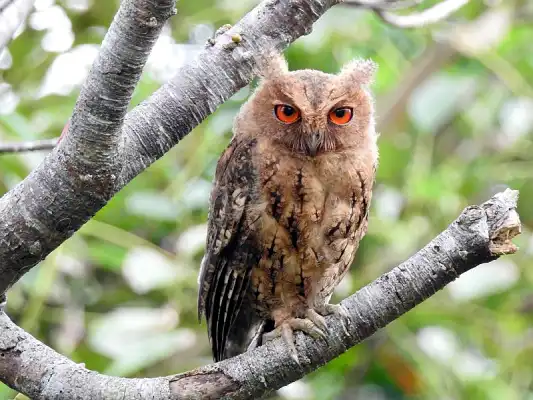
- Scientific Name: Otus semitorques
- Length: 9.8 in
- Wingspan: 24.8 in
- Weight: 7 oz
Japanese scops-owls are permanent residents of Japan.
They are also found in Russia, Korea, and China, in different forested habitats like forested hillsides, wooded plains, and lowland forests.
They have grayish-brown plumage, prominent ear tufts, and dark red eyes. Japanese scops-owls resemble Ryuku scops-owls and oriental scops-owls but these two have yellow-orange eyes.
These birds of prey are vocal and will make different barking calls, croaking, and meowing sounds, as well as shrill screeches.
Japanese scops-owls can be seen on Tobishima island, Miyakejima island, Naritasan Park, Shimanto town, Nakanoshima, Yatsushiro, etc.
Ryūkyū scops-owl
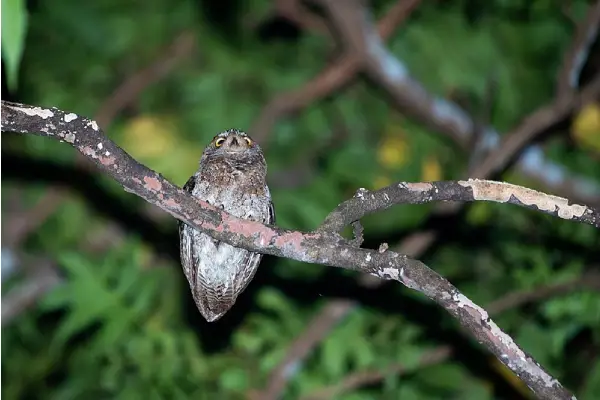
- Scientific Name: Otus elegans
- Length: 7.8 in
- Wingspan: n/a
- Weight: 2.5-4.4 oz
Ryukyu scops-owls, also known as elegant scops-owls, are permanent residents of Japan.
These small birds of prey have brownish plumage, short ear tufts, yellow eyes, and pale faces bordered with black.
Ryuku scops-owls are common in tropical and subtropical evergreen forests but might be hard to spot – try to identify them by their long series of hiccuping hoots.
They are carnivores and feed on different insects, spiders, and lizards. Ryukyu scops-owls can be seen in Japan on the Ryukyu and Daito islands.
Read More: List of owls that hoot
Oriental scops-owl
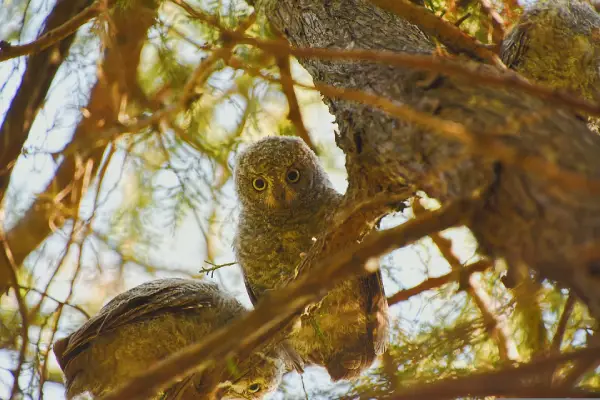
- Scientific Name: Otus sunia
- Length: 7.5 in
- Wingspan: 17-20.8 in
- Weight: 3 oz
Oriental scops-owls are breeding residents of Japan and can be seen there during summer.
These small owls can be recognized by bright yellow eyes, short ear tufts, and grayish-brown or bright rufous plumage.
Oriental scops-owls inhabit parks, gardens, and forests, ranging from lowlands to foothills – they can be also identified by their repeated “tuk-tok-torok” calls.
There are 9 subspecies and the one found in Japan is the o.s. japonicus.
These nocturnal raptors hunt around dusk and feed on insects, spiders, rodents, and birds. In Japan, oriental scops-owls lay eggs from May to June and have 3-4 white eggs that the female incubates while the male feeds her.
Oriental scops-owls can be seen in Japan in Hokkaido, Hegurajima, Ishigaki, Kakeromajima island, etc.
Fun Fact: Oriental scops-owls have been also spotted twice in the USA. In both situations, the birds were seen on the Aleutian Islands off the coast of Alaska.
Eurasian eagle-owl

- Scientific Name: Bubo bubo
- Length: 22-30 in
- Wingspan: 51.5-74 in
- Weight: 2.6-10.1 lb
Eurasian eagle-owls are mostly vagrant visitors to Japan.
These huge and powerful owls are common in Europe and Asia, in various habitats ranging from forests to rocky canyons.
They are also called the Uhu and have very pronounced ear tufts, streaked underparts, and bright orange eyes.
Eurasian eagle-owls are among the largest species of owls and apex predators; they hunt at night and use their acute hearing to locate prey.
Pairs will often sing in a duet, exchanging a series of deep and high-pitched hoots.
Of the 12 subspecies of Eurasian eagle-owls, only one (B. b. ussuriensis) can be called the Japanese representative. The subspecies can be found in parts of northern Hokkaido, but they do not have a stable population there.
Make sure to check our list of owls with blue eyes and see what Eurasian eagle-owls would look like with blue irises.
Snowy owl
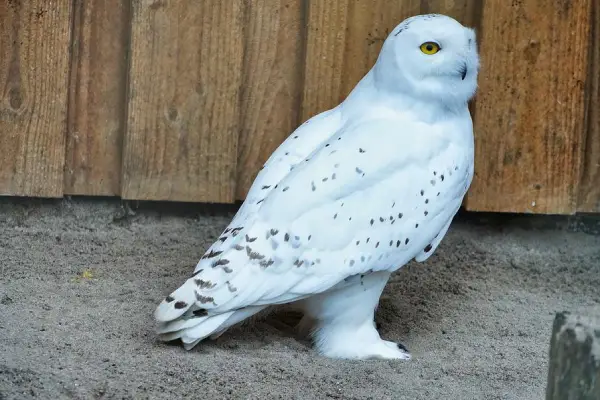
- Scientific Name: Bubo scandiacus
- Length: 21-28 in
- Wingspan: 45-72 in
- Weight: 2.9-6.5 lb
Snowy owls are also vagrant visitors of Japan during the winter or summer, although in very small numbers (1-2 birds per year).
These enormous white birds of prey are among the largest species and the only white owls in the world – they also have bright yellow eyes.
Snowy owls sleep at night, hunt during the day, and have a diet that includes small mammals, some water birds, fish, and even carrion.
Their favorite food is lemmings (small mouselike rodents) – snowy owls might hunt as much as 1,600 of those per year. These beautiful birds are monogamous and mate for life.
Snowy owls are just one of many white-colored birds of prey – check out the full list here.
Blakiston’s fish-owl
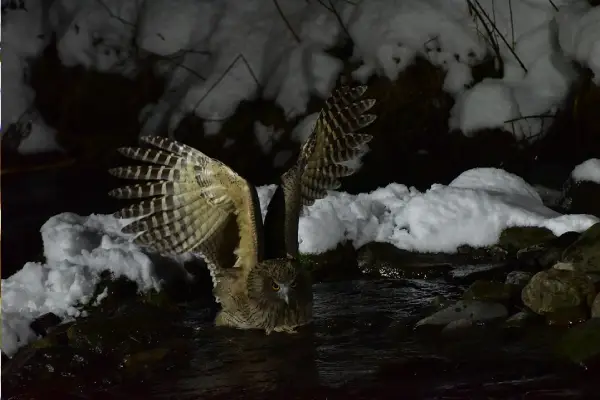
- Scientific Name: Bubo blakistoni
- Length: 23.6-28.3 in
- Wingspan: 70.8-74.8 in
- Weight: 6.5-10 lb
Blakiston’s fish-owls are permanent residents of Japan found mostly on Hokkaido island.
These endangered birds are the largest living owl species weighing up to 10 pounds (females are around 25% larger than males).
They were named after the English naturalist Thomas Blakiston who was the first to describe them in 1883 in Hokkaido.
Blakiston’s fish-owls are brown with rounded ear tufts, gray beaks, and orange-yellow eyes. They inhabit mature boreal forests near streams with tree holes to nest in.
As the name suggests, Blakiston’s fish-owls primarily feed on fish, and some crustaceans, birds, and bats. They have short and deep “boo-bo-voo” territorial calls; the pairs will often sing in duets with the male calling twice and the female responding with one note.
These owls native to Japan can be differentiated from Eurasian eagle-owls by the lack of black breast streaks and rounder ear tufts.
Ural owl

- Scientific Name: Strix uralensis
- Length: 19.7-24.4 in
- Wingspan: 48.8-52.7 in
- Weight: 1-3.2 lb
Ural owls are permanent residents of Japan and are found throughout the country.
These large owls can be identified by their small dark eyes, bright yellow beaks, pale gray to dark brown plumage, and lack of ear tufts.
Ural owls inhabit deciduous or mixed forests and woodlands with clearings where they feed on voles, shrews, rats, mice, birds, insects, and lizards. They are nocturnal and hunt at night, detecting their prey by sound.
Ural owls are monogamous and stay together for years, often for life. To strengthen their bond, males will sing and provide prey to females. Males also make deep, resonating hoots while the females emit higher, hoarser notes.
They nest in tree cavities and lay 3-4 white eggs.
Ural owls are found on all five of the main Japanese islands, being only absent from Okinawa/Ryukyu Islands to the south.
Read More: List of owls with black irises
Long-eared owl
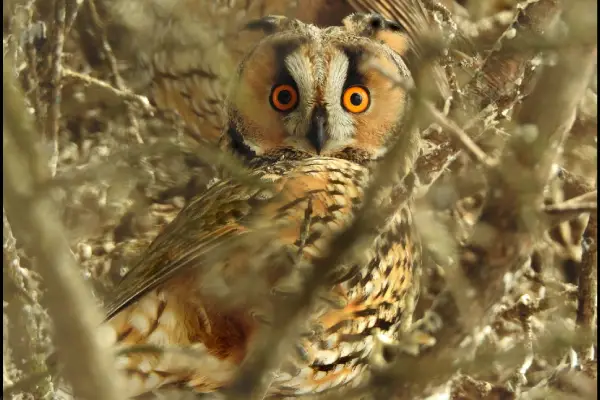
- Scientific Name: Asio otus
- Length: 12-16 in
- Wingspan: 34-40 in
- Weight: 9-15 oz
Long-eared owls are permanent residents of Japan.
Also known as northern long-eared owls, lesser horned owls, or cat owls, these medium-sized owls with long ear tufts are also common in Europe, Asia, North America, and parts of Africa.
North American long-eared owls have yellow eyes, while their Eurasian counterparts have reddish ones.
Long-eared owls inhabit brushy thickets, conifer groves, and semi-open areas. They are specialized hunters, focusing entirely on small rodents. In Japan, they primarily consume Japanese grass voles, gray red-backed voles, and house mice.
Males can be extremely vocal and emit hoots that can be heard from over half a mile away.
Read More: Examples of owls with huge eyes
Short-eared owl

- Scientific Name: Asio flammeus
- Length: 13-17 in
- Wingspan: 33-43 in
- Weight: 7.3-16.8 oz
Short-eared owls are winter residents of Japan, typically seen in small numbers from September to April.
These medium-sized owls have mottled brown upperparts, whitish underparts, very short ear tufts, yellow eyes, and black beaks.
Although mostly silent, short-eared owls will make a series of “voo-hoo-hoo” calls during the breeding season. They are found in open country, around marshes, grasslands, montane forests, tundras, and savannas.
Short-eared owls are migratory birds that feed mostly on voles, rats, bats, mice, squirrels, rabbits, and some birds.
Places to see these owls in Japan include Hokkaido, Honshu, Shikoku, Kyushu, Izu Islands, etc.
Fun Fact: Short-eared owls will often harass falcons, herons, and eagles, just for fun!
Boreal owl
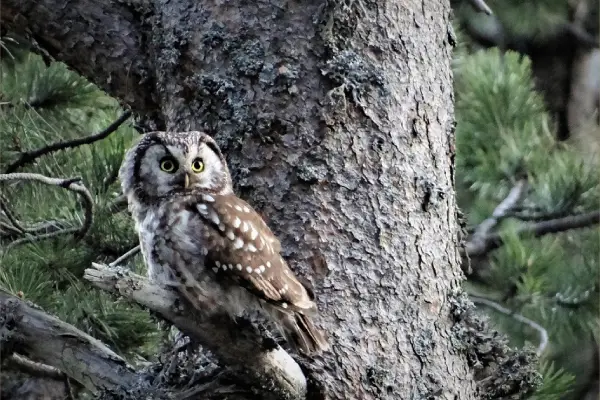
- Scientific Name: Aegolius funereus
- Length: 8-11 in
- Wingspan: 20-24 in
- Weight: 3-7 oz
Boreal owls are rare visitors to Hokkaido island of Japan.
These small owls with large heads are common in boreal, highland, and mixed woodlands, where they nest in tree holes. They hunt during the night and roost during the day, staying well-camouflaged in dense vegetation.
Boreal owls are also known as Tengmalm’s owls (after Swedish naturalist Peter Gustaf Tengmalm) and can be identified by their dark brown upperparts, white spots on backs and rumps, conspicuous facial disks, yellow hooked beaks, and yellow eyes.
Males make a series of deep “po-po” hoots during the breeding season while females make aggressive “kwahk” calls.
Similar to other owls, these raptors feed on voles, lemmings, mice, moles, frogs, birds, bats, and insects. Because of their evasive nature, nocturnal activity, and hard-to-access habitats, boreal owls might be hard to spot.
Boreal owls do not have a very long life, reaching only 7 or 8 years of age.
Northern boobook
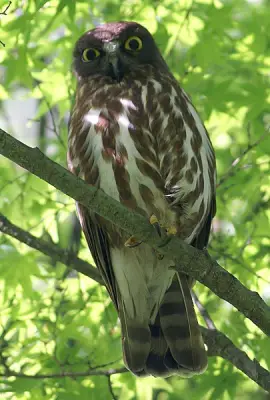
- Scientific Name: Ninox japonica
- Length: 12.6 in
- Wingspan: 26.7 in
- Weight: 5.9-8.8 oz
Northern boobooks are summer residents of Japan when they are more abundant than Ural owls.
Northern boobooks were once considered a subspecies of brown boobooks and despite being one of the most common breeding owls in Japan, there haven’t been too many studies of the species.
Northern boobooks are medium-sized owls with very expressive golden-yellow eyes and the absence of ear tufts and facial disks.
They inhabit different forests, including lowland deciduous forests, coniferous forests, parks, gardens, plantations, and even swamps.
Identify them also by their sharp “heeoo,” quiet “kerr,” and cat-like “mew” calls.
In Japan, northern boobooks breed from May to June and lay 3-4 white eggs. They are carnivores and mainly feed on insects, bats, some lizards, and small birds.
Read More: All eagle species found in Japan
Summary
This concludes our list of owls found in Japan.
Out of the 12 species of owls found in Japan, 5 are considered permanent residents, 1 is a winter, 2 are summer visitors, while the rests are vagrant (rare) visitors there.
Japanese people consider owls to bring good luck and protection, symbolizing wisdom and fortune.
And if you enjoyed our article, here are our other popular reads on birds: List of owls that are brown